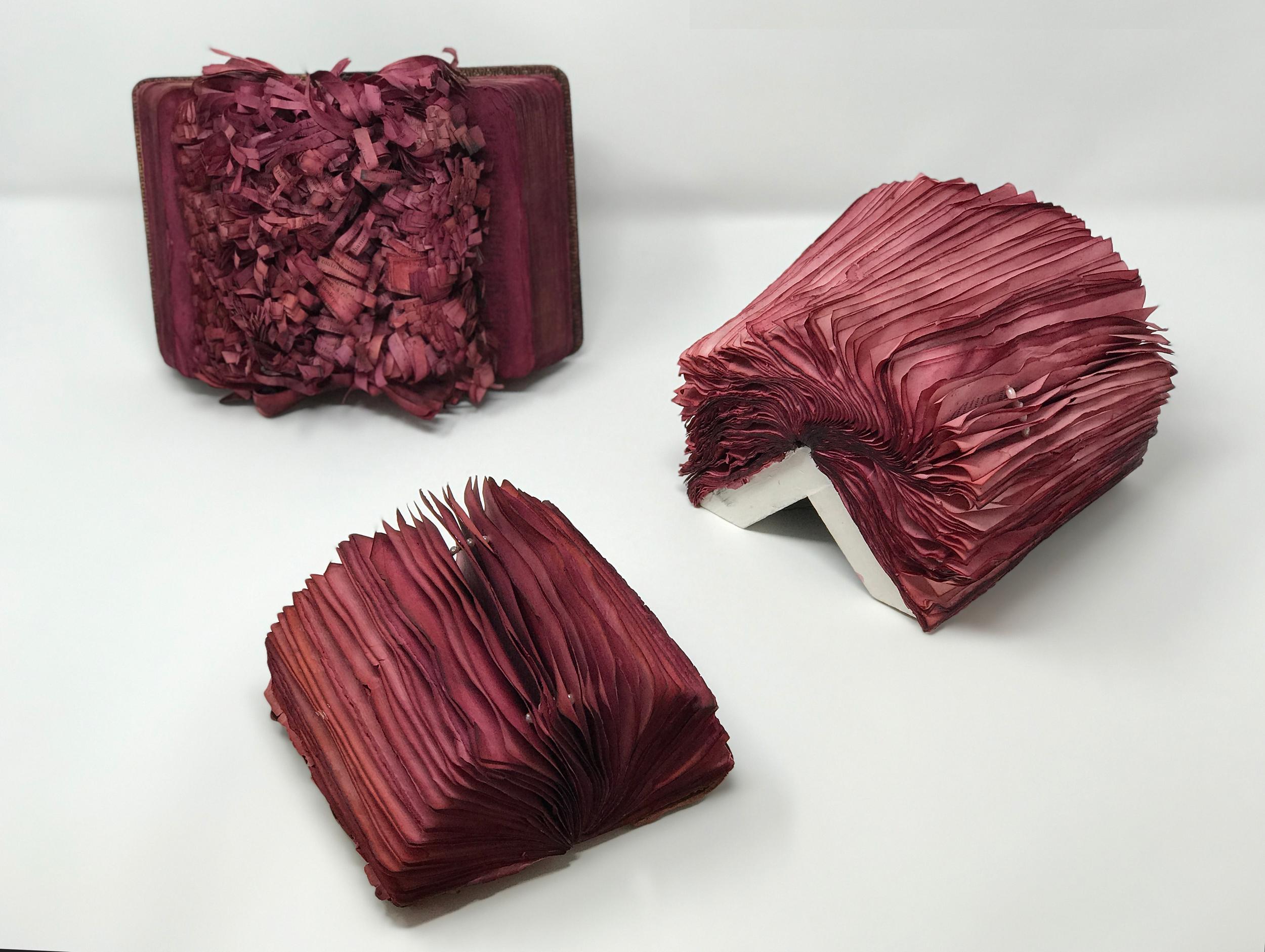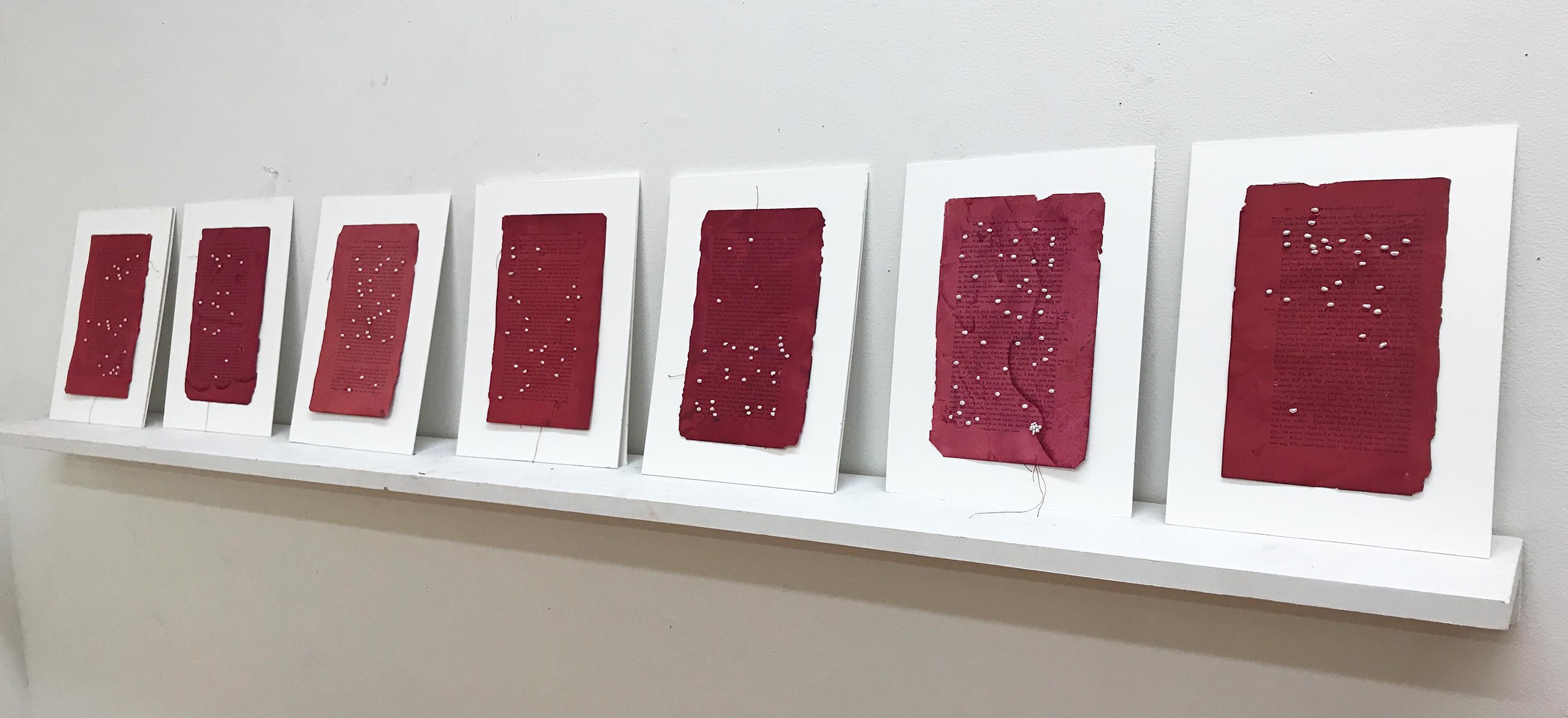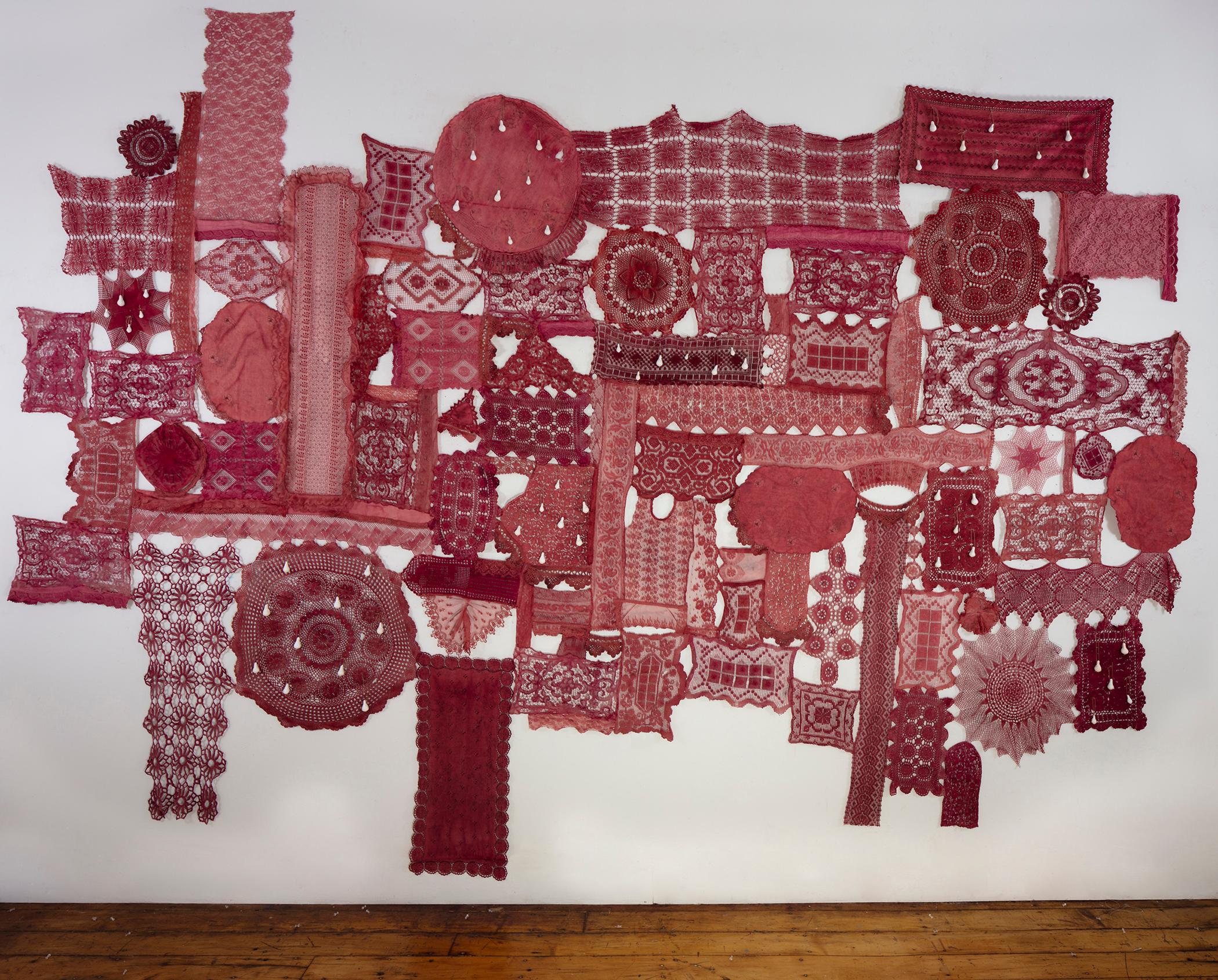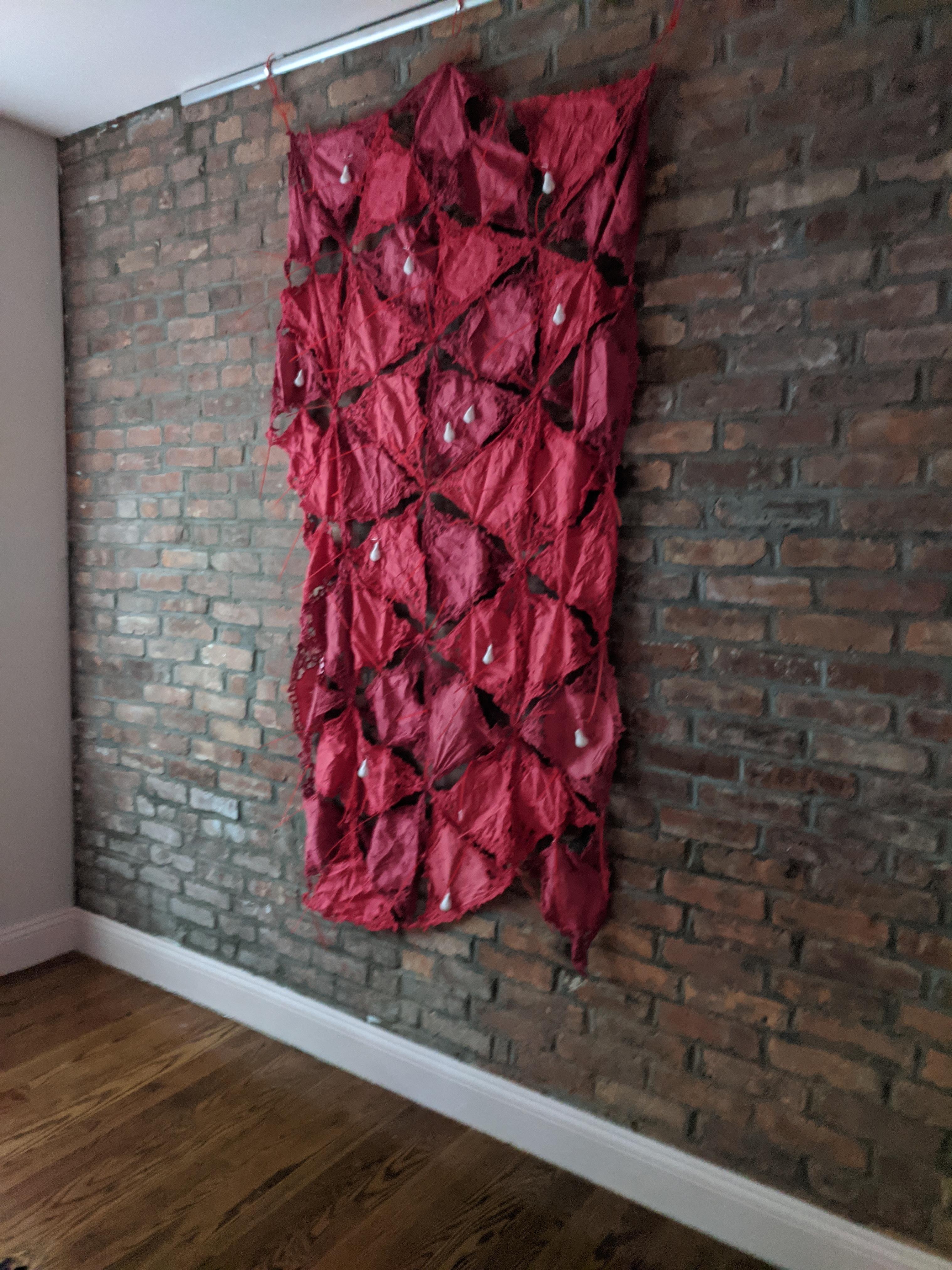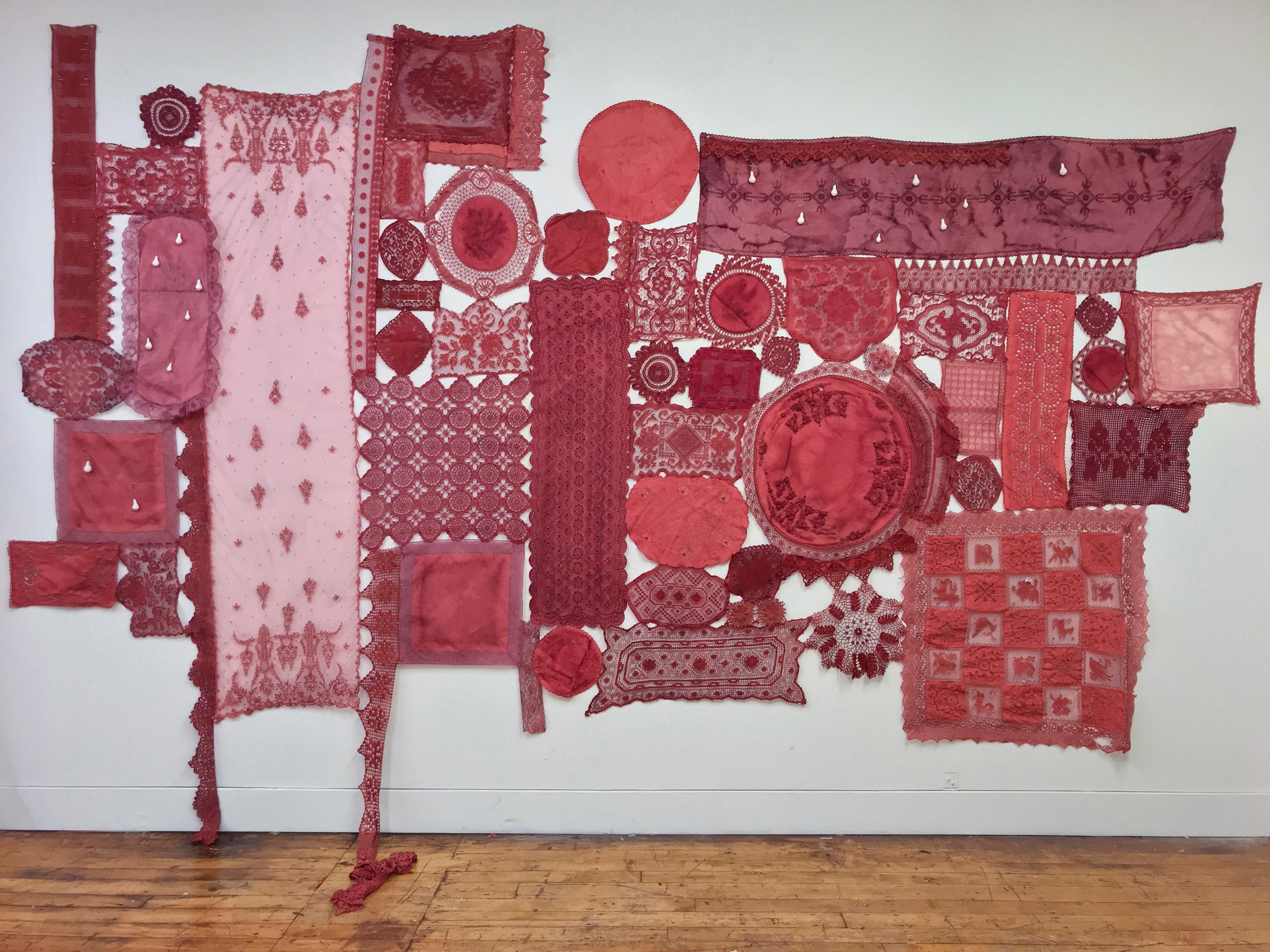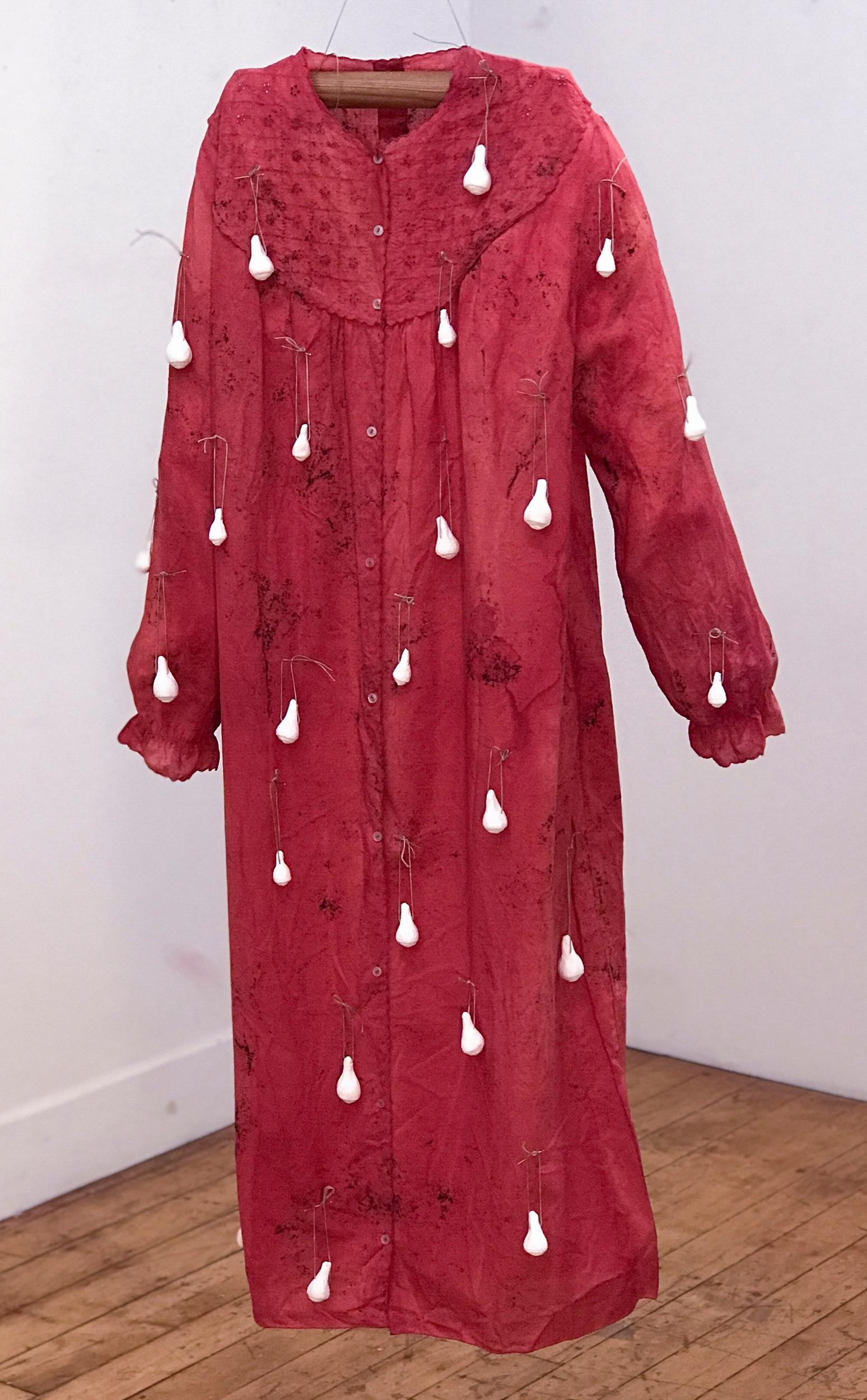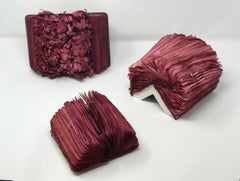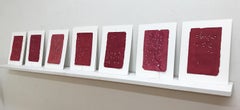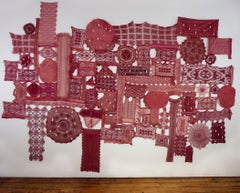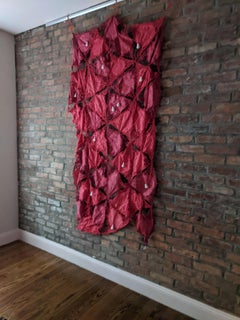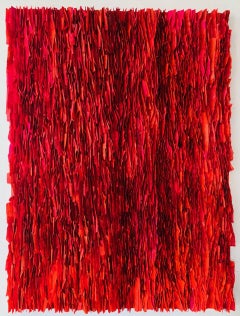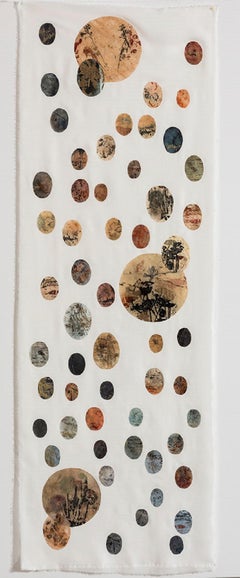Items Similar to Patricia Miranda, Florilegium Series, 2016, cochineal dyes, antique books, pearl
Want more images or videos?
Request additional images or videos from the seller
1 of 6
Patricia MirandaPatricia Miranda, Florilegium Series, 2016, cochineal dyes, antique books, pearl2016
2016
$1,500
�£1,145.24
€1,323.32
CA$2,105.72
A$2,347.04
CHF 1,231.41
MX$28,661.18
NOK 15,592.34
SEK 14,737.14
DKK 9,876.50
About the Item
Patricia Miranda's work includes interdisciplinary installation, textile, paper and books. The textiles incorporated in these new pieces are vintage linens from her Italian and Irish grandmothers and sourced from friends and strangers around the country. Each donation is documented and integrated into the work. Textile as a form that wraps the body from cradle to grave. The role of lacemaking in the lives of women both economically and historically is packed with metaphorical potential. The relationship of craft and women’s work (re)appropriated by artists today to environmental and social issues is integral to the artist's research.
Her work is process oriented; materials are submerged in natural dyes from oak gall wasp nests, cochineal insects, turmeric, indigo, and clay. She forages for raw materials, cook dyes, grind pigments, ecofeminist actions that consider environmental impacts of objects. The process is left visible as dyestuff is unfiltered in the vat and finished work. Sewn into larger works, Miranda incorporates hair, pearls, bone beads, Milagros, cast plaster. The distinct genetics and environmental and cultural history of each material asserts its voice as collaborator rather than medium.
The lace inserts a visceral femininity into the pristine gallery, and exerts a ghostly trace of the history of domestic labor. The combination of earth and lace references human and environmental devastation and the conflation of nature and women’s bodies as justifications for exploitation. Mournful and solastalgic, they are lamentations to the violence against women and the earth.
Patricia Miranda is an interdisciplinary artist, curator, educator, and founder of The Crit Lab, graduate-level critique seminars and Residency for artists, and MAPSpace project space. She has been Visiting Artist at Vermont Studio Center, the Heckscher Museum, and University of Utah; and been awarded residencies at I-Park, Weir Farm, Vermont Studio Center, and Julio Valdez Printmaking Studio.
She received an Anonymous Was a Woman Covid19 Artist Relief Grant, an artist grant from ArtsWestchester/New York State Council on the Arts, and was part of a year-long NEA grant working with homeless youth.
Miranda currently teaches graduate curatorial studies at Western Colorado University, and develops programs for K-12, museums, and institutions such as Franklin Furnace.
Her work has been exhibited at ODETTA, NYC; ABC No Rio, NYC; Alexey von Schlippe Gallery at UConn, Groton, CT; Wave Hill, Bronx, NY; the Cape Museum of Fine Art, MA; the Belvedere Museum, Vienna, Austria.
- Creator:
- Creation Year:2016
- Dimensions:Height: 7 in (17.78 cm)Width: 12 in (30.48 cm)Depth: 6 in (15.24 cm)
- Medium:
- Movement & Style:
- Period:
- Condition:These book range in price from $1000-$1500 depending on size. This work of art requires professional handling. The artist is available to advise or install the project for an additional fee. Contact the gallery for more information.
- Gallery Location:Darien, CT
- Reference Number:1stDibs: LU17226667322
About the Seller
5.0
Vetted Professional Seller
Every seller passes strict standards for authenticity and reliability
Established in 2014
1stDibs seller since 2015
143 sales on 1stDibs
Typical response time: 6 hours
- ShippingRetrieving quote...Shipping from: Darien, CT
- Return Policy
Authenticity Guarantee
In the unlikely event there’s an issue with an item’s authenticity, contact us within 1 year for a full refund. DetailsMoney-Back Guarantee
If your item is not as described, is damaged in transit, or does not arrive, contact us within 7 days for a full refund. Details24-Hour Cancellation
You have a 24-hour grace period in which to reconsider your purchase, with no questions asked.Vetted Professional Sellers
Our world-class sellers must adhere to strict standards for service and quality, maintaining the integrity of our listings.Price-Match Guarantee
If you find that a seller listed the same item for a lower price elsewhere, we’ll match it.Trusted Global Delivery
Our best-in-class carrier network provides specialized shipping options worldwide, including custom delivery.More From This Seller
View AllPatricia Miranda, Florilegium Series, 2016, cochineal dyes, antique books, pearl
By Patricia Miranda
Located in Darien, CT
Patricia Miranda's work includes interdisciplinary installation, textile, paper and books. The textiles incorporated in these new pieces are vintage linens from her Italian and Irish grandmothers and sourced from friends and strangers around the country. Each donation is documented and integrated into the work. Textile as a form that wraps the body from cradle to grave. The role of lacemaking in the lives of women both economically and historically is packed with metaphorical potential. The relationship of craft and women’s work (re)appropriated by artists today to environmental and social issues is integral to the artist's research.
Her work is process oriented; materials are submerged in natural dyes from oak gall wasp nests, cochineal insects, turmeric, indigo, and clay. She forages for raw materials, cook dyes, grind pigments, ecofeminist actions that consider environmental impacts of objects. The process is left visible as dyestuff is unfiltered in the vat and finished work. Sewn into larger works, Miranda incorporates hair, pearls, bone beads, Milagros, cast plaster. The distinct genetics and environmental and cultural history of each material asserts its voice as collaborator rather than medium.
The lace inserts a visceral femininity into the pristine gallery, and exerts a ghostly trace of the history of domestic labor. The combination of earth and lace references human and environmental devastation and the conflation of nature and women’s bodies as justifications for exploitation. Mournful and solastalgic, they are lamentations to the violence against women and the earth.
Patricia Miranda is an interdisciplinary artist, curator, educator, and founder of The Crit Lab, graduate-level critique seminars and Residency for artists, and MAPSpace project space. She has been Visiting Artist at Vermont Studio Center, the Heckscher Museum, and University of Utah; and been awarded residencies at I-Park, Weir Farm, Vermont Studio Center, and Julio Valdez Printmaking Studio.
She received an Anonymous Was a Woman Covid19 Artist Relief Grant, an artist grant from ArtsWestchester/New York State Council on the Arts, and was part of a year-long NEA grant working with homeless youth.
Miranda currently teaches graduate curatorial studies at Western Colorado University, and develops programs for K-12, museums, and institutions such as Franklin Furnace.
Her work has been exhibited at ODETTA, NYC; ABC No Rio, NYC; Alexey von...
Category
2010s Feminist Abstract Sculptures
Materials
Fabric, Thread, Plaster, Dye, Found Objects
Patricia Miranda, Pearls Before Swine 2020, cochineal dyes, pages, sewn pearls
By Patricia Miranda
Located in Darien, CT
Patricia Miranda's work includes interdisciplinary installation, textile, paper and books. The textiles incorporated in these new pieces are vintage linens from her Italian and Irish grandmothers and sourced from friends and strangers around the country. Each donation is documented and integrated into the work. Textile as a form that wraps the body from cradle to grave. The role of lacemaking in the lives of women both economically and historically is packed with metaphorical potential. The relationship of craft and women’s work (re)appropriated by artists today to environmental and social issues is integral to the artist's research.
Her work is process oriented; materials are submerged in natural dyes from oak gall wasp nests, cochineal insects, turmeric, indigo, and clay. She forages for raw materials, cook dyes, grind pigments, ecofeminist actions that consider environmental impacts of objects. The process is left visible as dyestuff is unfiltered in the vat and finished work. Sewn into larger works, Miranda incorporates hair, pearls, bone beads, Milagros, cast plaster. The distinct genetics and environmental and cultural history of each material asserts its voice as collaborator rather than medium.
The lace inserts a visceral femininity into the pristine gallery, and exerts a ghostly trace of the history of domestic labor. The combination of earth and lace references human and environmental devastation and the conflation of nature and women’s bodies as justifications for exploitation. Mournful and solastalgic, they are lamentations to the violence against women and the earth.
Patricia Miranda is an interdisciplinary artist, curator, educator, and founder of The Crit Lab, graduate-level critique seminars and Residency for artists, and MAPSpace project space. She has been Visiting Artist at Vermont Studio Center, the Heckscher Museum, and University of Utah; and been awarded residencies at I-Park, Weir Farm, Vermont Studio Center, and Julio Valdez Printmaking Studio.
She received an Anonymous Was a Woman Covid19 Artist Relief Grant, an artist grant from ArtsWestchester/New York State Council on the Arts, and was part of a year-long NEA grant working with homeless youth.
Miranda currently teaches graduate curatorial studies at Western Colorado University, and develops programs for K-12, museums, and institutions such as Franklin Furnace.
Her work has been exhibited at ODETTA, NYC; ABC No Rio, NYC; Alexey von...
Category
2010s Feminist Abstract Sculptures
Materials
Thread, Dye, Found Objects
Patricia Miranda, Lamentations for Ermenegilda; 2020, lace, cochineal dye, thread
By Patricia Miranda
Located in Darien, CT
Patricia Miranda's work includes interdisciplinary installation, textile, paper and books. The textiles incorporated in these new pieces are vintage linens from her Italian and Irish grandmothers and sourced from friends and strangers around the country. Each donation is documented and integrated into the work. Textile as a form that wraps the body from cradle to grave. The role of lacemaking in the lives of women both economically and historically is packed with metaphorical potential. The relationship of craft and women’s work (re)appropriated by artists today to environmental and social issues is integral to the artist's research.
Her work is process oriented; materials are submerged in natural dyes from oak gall wasp nests, cochineal insects, turmeric, indigo, and clay. She forages for raw materials, cook dyes, grind pigments, ecofeminist actions that consider environmental impacts of objects. The process is left visible as dyestuff is unfiltered in the vat and finished work. Sewn into larger works, Miranda incorporates hair, pearls, bone beads, Milagros, cast plaster. The distinct genetics and environmental and cultural history of each material asserts its voice as collaborator rather than medium.
The lace inserts a visceral femininity into the pristine gallery, and exerts a ghostly trace of the history of domestic labor. The combination of earth and lace references human and environmental devastation and the conflation of nature and women’s bodies as justifications for exploitation. Mournful and solastalgic, they are lamentations to the violence against women and the earth.
Patricia Miranda is an interdisciplinary artist, curator, educator, and founder of The Crit Lab, graduate-level critique seminars and Residency for artists, and MAPSpace project space. She has been Visiting Artist at Vermont Studio Center, the Heckscher Museum, and University of Utah; and been awarded residencies at I-Park, Weir Farm, Vermont Studio Center, and Julio Valdez Printmaking Studio.
She received an Anonymous Was a Woman Covid19 Artist Relief Grant, an artist grant from ArtsWestchester/New York State Council on the Arts, and was part of a year-long NEA grant working with homeless youth.
Miranda currently teaches graduate curatorial studies at Western Colorado University, and develops programs for K-12, museums, and institutions such as Franklin Furnace.
Her work has been exhibited at ODETTA, NYC; ABC No Rio, NYC; Alexey von...
Category
2010s Feminist Abstract Sculptures
Materials
Ceramic, Fabric, Thread, Dye, Found Objects
Patricia Miranda, Sentinella, 2020, Battinger lace, synthetic dyes, cast plaster
By Patricia Miranda
Located in Darien, CT
Patricia Miranda's work includes interdisciplinary installation, textile, paper and books. The textiles incorporated in these new pieces are vintage linens from her Italian and Irish grandmothers and sourced from friends and strangers around the country. Each donation is documented and integrated into the work. Textile as a form that wraps the body from cradle to grave. The role of lacemaking in the lives of women both economically and historically is packed with metaphorical potential. The relationship of craft and women’s work (re)appropriated by artists today to environmental and social issues is integral to the artist's research.
Her work is process oriented; materials are submerged in natural dyes from oak gall wasp nests, cochineal insects, turmeric, indigo, and clay. She forages for raw materials, cook dyes, grind pigments, ecofeminist actions that consider environmental impacts of objects. The process is left visible as dyestuff is unfiltered in the vat and finished work. Sewn into larger works, Miranda incorporates hair, pearls, bone beads, Milagros, cast plaster. The distinct genetics and environmental and cultural history of each material asserts its voice as collaborator rather than medium.
The lace inserts a visceral femininity into the pristine gallery, and exerts a ghostly trace of the history of domestic labor. The combination of earth and lace references human and environmental devastation and the conflation of nature and women’s bodies as justifications for exploitation. Mournful and solastalgic, they are lamentations to the violence against women and the earth.
Patricia Miranda is an interdisciplinary artist, curator, educator, and founder of The Crit Lab, graduate-level critique seminars and Residency for artists, and MAPSpace project space. She has been Visiting Artist at Vermont Studio Center, the Heckscher Museum, and University of Utah; and been awarded residencies at I-Park, Weir Farm, Vermont Studio Center, and Julio Valdez Printmaking Studio.
She received an Anonymous Was a Woman Covid19 Artist Relief Grant, an artist grant from ArtsWestchester/New York State Council on the Arts, and was part of a year-long NEA grant working with homeless youth.
Miranda currently teaches graduate curatorial studies at Western Colorado University, and develops programs for K-12, museums, and institutions such as Franklin Furnace.
Her work has been exhibited at ODETTA, NYC; ABC No Rio, NYC; Alexey von...
Category
2010s Feminist Abstract Sculptures
Materials
Fabric, Dye, Plastic
Patricia Miranda, Lamentations for Rebecca; 2020, lace, cochineal dye, thread
By Patricia Miranda
Located in Darien, CT
Patricia Miranda's work includes interdisciplinary installation, textile, paper and books. The textiles incorporated in these new pieces are vintage linens from her Italian and Irish grandmothers and sourced from friends and strangers around the country. Each donation is documented and integrated into the work. Textile as a form that wraps the body from cradle to grave. The role of lacemaking in the lives of women both economically and historically is packed with metaphorical potential. The relationship of craft and women’s work (re)appropriated by artists today to environmental and social issues is integral to the artist's research.
Her work is process oriented; materials are submerged in natural dyes from oak gall wasp nests, cochineal insects, turmeric, indigo, and clay. She forages for raw materials, cook dyes, grind pigments, ecofeminist actions that consider environmental impacts of objects. The process is left visible as dyestuff is unfiltered in the vat and finished work. Sewn into larger works, Miranda incorporates hair, pearls, bone beads, Milagros, cast plaster. The distinct genetics and environmental and cultural history of each material asserts its voice as collaborator rather than medium.
The lace inserts a visceral femininity into the pristine gallery, and exerts a ghostly trace of the history of domestic labor. The combination of earth and lace references human and environmental devastation and the conflation of nature and women’s bodies as justifications for exploitation. Mournful and solastalgic, they are lamentations to the violence against women and the earth.
Patricia Miranda is an interdisciplinary artist, curator, educator, and founder of The Crit Lab, graduate-level critique seminars and Residency for artists, and MAPSpace project space. She has been Visiting Artist at Vermont Studio Center, the Heckscher Museum, and University of Utah; and been awarded residencies at I-Park, Weir Farm, Vermont Studio Center, and Julio Valdez Printmaking Studio.
She received an Anonymous Was a Woman Covid19 Artist Relief Grant, an artist grant from ArtsWestchester/New York State Council on the Arts, and was part of a year-long NEA grant working with homeless youth.
Miranda currently teaches graduate curatorial studies at Western Colorado University, and develops programs for K-12, museums, and institutions such as Franklin Furnace.
Her work has been exhibited at ODETTA, NYC; ABC No Rio, NYC; Alexey von...
Category
2010s Feminist Abstract Sculptures
Materials
Ceramic, Fabric, Thread, Dye, Found Objects
Patricia Miranda, Dreaming Awake, 2020, nightdress, cochineal dyes, plaster,
By Patricia Miranda
Located in Darien, CT
Patricia Miranda's work includes interdisciplinary installation, textile, paper and books. The textiles incorporated in these new pieces are vintage linens from her Italian and Irish grandmothers and sourced from friends and strangers around the country. Each donation is documented and integrated into the work. Textile as a form that wraps the body from cradle to grave. The role of lacemaking in the lives of women both economically and historically is packed with metaphorical potential. The relationship of craft and women’s work (re)appropriated by artists today to environmental and social issues is integral to the artist's research.
Her work is process oriented; materials are submerged in natural dyes from oak gall wasp nests, cochineal insects, turmeric, indigo, and clay. She forages for raw materials, cook dyes, grind pigments, ecofeminist actions that consider environmental impacts of objects. The process is left visible as dyestuff is unfiltered in the vat and finished work. Sewn into larger works, Miranda incorporates hair, pearls, bone beads, Milagros, cast plaster. The distinct genetics and environmental and cultural history of each material asserts its voice as collaborator rather than medium.
The lace inserts a visceral femininity into the pristine gallery, and exerts a ghostly trace of the history of domestic labor. The combination of earth and lace references human and environmental devastation and the conflation of nature and women’s bodies as justifications for exploitation. Mournful and solastalgic, they are lamentations to the violence against women and the earth.
Patricia Miranda is an interdisciplinary artist, curator, educator, and founder of The Crit Lab, graduate-level critique seminars and Residency for artists, and MAPSpace project space. She has been Visiting Artist at Vermont Studio Center, the Heckscher Museum, and University of Utah; and been awarded residencies at I-Park, Weir Farm, Vermont Studio Center, and Julio Valdez Printmaking Studio.
She received an Anonymous Was a Woman Covid19 Artist Relief Grant, an artist grant from ArtsWestchester/New York State Council on the Arts, and was part of a year-long NEA grant working with homeless youth.
Miranda currently teaches graduate curatorial studies at Western Colorado University, and develops programs for K-12, museums, and institutions such as Franklin Furnace.
Her work has been exhibited at ODETTA, NYC; ABC No Rio, NYC; Alexey von...
Category
2010s Feminist Abstract Sculptures
Materials
Fabric, Thread, Dye, Found Objects, Plaster
You May Also Like
Nancy Cohen "Rose Lines" 2024 paper pulp, kozo fiber and handmade paper
By Nancy Cohen
Located in New York, NY
Nancy Cohen
Rose Lines, 2024
paper pulp, kozo fiber and handmade paper
17 x 49 in
(coh109)
Category
2010s Contemporary Mixed Media
Materials
Paper, Handmade Paper
Paisajes del Pensamiento II. Mixed Media Wall Sculpture
Located in Miami Beach, FL
The Landscapes of Thought project is inspired by the impermanent nature of all things. Observing the continuous transformation of the environment, of time, of thought, is one of the ...
Category
2010s Abstract Abstract Sculptures
Materials
Fabric, Textile, Mixed Media
Quantum Color #47 Mixed media painted books on a wood panel
By Natasha Zupan
Located in Miami Beach, FL
Natasha Zupan beautifully unites the old and new, combining the innovation of her highly crafted technique with her wonder for tradition and the great Masters. This body of work expl...
Category
2010s Abstract Mixed Media
Materials
Paper, Acrylic, Wood Panel
Japanese Botany, Original Contemporary Abstract Mixed Media Textile Wall Hanging
Located in Boston, MA
Japanese Botany, Original Contemporary Abstract Mixed Media Textile Wall Hanging
Artist Commentary:
INSPIRED IN JAPANESE AESTHETICS
Keywords: Abstract, Nature, patterns, circles, ovals, white
Artist Biography:
My artwork is engaged to nature and its recurrent patterns and rhythms. I use them as a base in order to create my compositions. I´m attracted to repetitive sequences, combining separate elements to form a cohesive group. It isn’t a strict conceptual idea of repetition on itself; my work doesn’t seek to impose an order or structure, but rather to enjoy the rhythm of repetition. Silk and paper have the softness and malleability that I need in order to create my desired forms, shapes and even shadows. The process to carry out my work is thorough and methodical. I choose as materials small and simple elements; such as feathers made out of paper and silk and then organized in a precise order. This allows me to build a group of entities that end up being the final artwork. My goal is to create projects that inspire, connect and touch people emotionally, taking the viewer on a journey through different ethereal, botanical and peaceful landscapes. I was Born in Santiago, Chile in 1973. I grew up surrounded by Chilean...
Category
21st Century and Contemporary Abstract Mixed Media
Materials
Linen, Silk, Etching
"Moving Inside Out" Abstract, Hanging Wall Relief Sculpture, Handmade Paper
By Joan Giordano
Located in New York, NY
"Moving Inside Out" from the "Presences" series by Joan Giordano
Mixed Media, Caste Handmade Paper (made from Kozo or Abaca Paper with natural pigment), Bamboo, Encaustic Wax, Steel...
Category
2010s Abstract Mixed Media
Materials
Steel
3D Work on found book pages: 'Nervous Tissue 1'
By Valerie Huhn
Located in New York, NY
Fingerprints were once used as a symbolic action of pride, but in our society they have become a passive action—we are fingerprinted. We can use our fingerprints to unlock the data ...
Category
2010s Contemporary Figurative Paintings
Materials
Mixed Media
More Ways To Browse
Bone Beads
Raw Pearl
Large Plaster Relief
Italian Plaster Relief
Andy Warhol Chanel
Antique Advertising Bicycles
Chinese Tiger Painting
Dior 2004 Shoes
Dune Poster
Francisco Santana
Harold Garde
Hound Dog Framed Oil Painting
Isle Of Skye
Japanese Male Nude
Linen Backed Jazz Posters
Lorjou Bernard
Malaga Vintage Poster
Mickey Mouse Figurines
